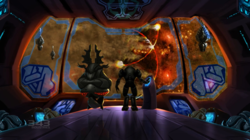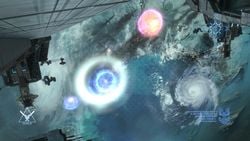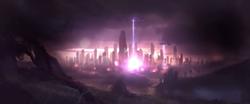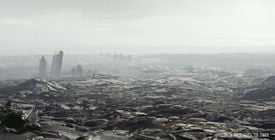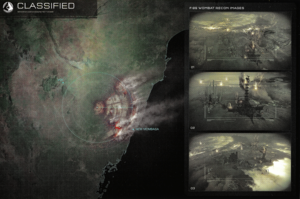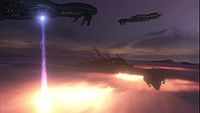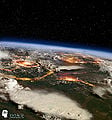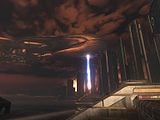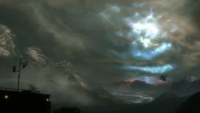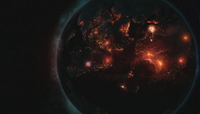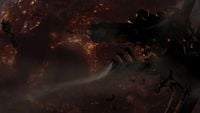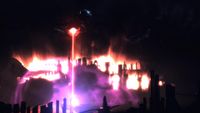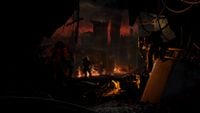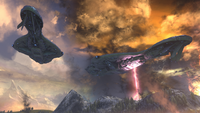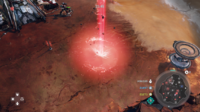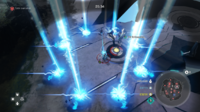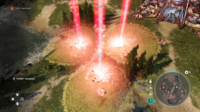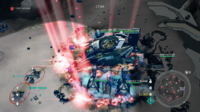Glassing: Difference between revisions
From Halopedia, the Halo wiki
m (→top: Replacing level links) |
m (Link clear up) |
||
| Line 12: | Line 12: | ||
Before bombardment commences, all Covenant ground operations cease and local forces are evacuated. The Covenant will then begin glassing the planet from orbit by moving their large warships close together, proceeding to blanket the world's population centers and the surrounding areas with a series of crisscrossing orbits to ensure that the planet is rendered uninhabitable.<ref name="fs130">'''Halo: First Strike''', ''page 130'' (2010 edition)</ref><ref name="doctrine" group="note">According to earlier media, such as the original printing of ''Halo: First Strike'', the Covenant glassed every square centimeter of a planet. However, later media show a more practical approach to glassing in which only part, perhaps most, of a planet is glassed in order to render it uninhabitable; the 2011 re-release of ''Halo: First Strike'' was [[List of rectified inconsistencies in the Halo series#Halo: First Strike|modified]] to accommodate this.</ref> The glassing of a planet by the Covenant is a very taxing process, and requires a massive amount of energy even for a [[Technological Achievement Tiers#Tier 2: Interstellar|Tier 2 civilization]];<ref>'''Halo: Evolutions''', "The Return", ''page 495''</ref><ref name="data10"/> Nevertheless, the Covenant are able to accomplish this feat in an effective manner. | Before bombardment commences, all Covenant ground operations cease and local forces are evacuated. The Covenant will then begin glassing the planet from orbit by moving their large warships close together, proceeding to blanket the world's population centers and the surrounding areas with a series of crisscrossing orbits to ensure that the planet is rendered uninhabitable.<ref name="fs130">'''Halo: First Strike''', ''page 130'' (2010 edition)</ref><ref name="doctrine" group="note">According to earlier media, such as the original printing of ''Halo: First Strike'', the Covenant glassed every square centimeter of a planet. However, later media show a more practical approach to glassing in which only part, perhaps most, of a planet is glassed in order to render it uninhabitable; the 2011 re-release of ''Halo: First Strike'' was [[List of rectified inconsistencies in the Halo series#Halo: First Strike|modified]] to accommodate this.</ref> The glassing of a planet by the Covenant is a very taxing process, and requires a massive amount of energy even for a [[Technological Achievement Tiers#Tier 2: Interstellar|Tier 2 civilization]];<ref>'''Halo: Evolutions''', "The Return", ''page 495''</ref><ref name="data10"/> Nevertheless, the Covenant are able to accomplish this feat in an effective manner. | ||
Glassing a planet can take a great deal of time, dependent upon both the tonnage and class of the vessels involved and how many ships are within the fleet. It could take as little as two days<ref>'''[[Halo Legends]]''', ''Halo: The Story So Far''</ref> or as much as two weeks<ref>'''[[Halo: The Fall of Reach]]''' (2010), ''Adjunct - page 389''</ref> or longer to complete the process. While partial glassing can be accomplished in a matter of days, covering the entire surface area to the last centimeter would take a prohibitive amount of time. The [[Assembly]] believed that, were the Covenant to commit thousands of ships to the task, it would have taken them around thirty years to completely glass [[Earth]] alone; Earth's relatively small size, along with a myriad of other factors, would likely cause the thorough glassing of larger planets to take even longer.<ref name="data10"/><ref name="fleet" group="note">While the Assembly asserts in Data Pad 10 that glassing a whole planet is a feat too impractical for the Covenant to feasibly achieve, the rest of canon contradicts this. Numerous instances are listed in the novels where glassing and glassed planets are observed, as well as in ''Halo: Reach'' where the data pads are from, since Reach's burnt surface is the opening shot of the game. Possible reasons for this discrepancy may be that the Assembly had only observed low-altitude bombardment, which is much slower and precise, or that they had misjudged the size of the full Covenant fleet, since they had based their figures on a fleet the size of the UNSC's. While the Assembly never explicitly retracts its statement, it does however state in Data Pad 14 that terraforming on the first eight colonies lost could take up to 3 centuries, an unusually long figure if those planets' full surfaces were never scorched. Based on the sum of the canon, it is thus assumed here that glassing is indeed a true method of attack by the Covenant.</ref> | Glassing a planet can take a great deal of time, dependent upon both the tonnage and class of the vessels involved and how many ships are within the fleet. It could take as little as two days<ref>'''[[Halo Legends]]''', ''Halo: The Story So Far''</ref> or as much as two weeks<ref>'''[[Halo: The Fall of Reach]]''' (2010), ''Adjunct - page 389''</ref> or longer to complete the process. While partial glassing can be accomplished in a matter of days, covering the entire surface area to the last centimeter would take a prohibitive amount of time. The [[The Assembly|Assembly]] believed that, were the Covenant to commit thousands of ships to the task, it would have taken them around thirty years to completely glass [[Earth]] alone; Earth's relatively small size, along with a myriad of other factors, would likely cause the thorough glassing of larger planets to take even longer.<ref name="data10"/><ref name="fleet" group="note">While the Assembly asserts in Data Pad 10 that glassing a whole planet is a feat too impractical for the Covenant to feasibly achieve, the rest of canon contradicts this. Numerous instances are listed in the novels where glassing and glassed planets are observed, as well as in ''Halo: Reach'' where the data pads are from, since Reach's burnt surface is the opening shot of the game. Possible reasons for this discrepancy may be that the Assembly had only observed low-altitude bombardment, which is much slower and precise, or that they had misjudged the size of the full Covenant fleet, since they had based their figures on a fleet the size of the UNSC's. While the Assembly never explicitly retracts its statement, it does however state in Data Pad 14 that terraforming on the first eight colonies lost could take up to 3 centuries, an unusually long figure if those planets' full surfaces were never scorched. Based on the sum of the canon, it is thus assumed here that glassing is indeed a true method of attack by the Covenant.</ref> | ||
The Covenant have been known to utilize two methods of glassing. | The Covenant have been known to utilize two methods of glassing. | ||
| Line 56: | Line 56: | ||
After the [[Hierarchs]]' declaration to exterminate humanity, the Covenant put all of their destructive methods to use. The first planet to suffer this fate was [[Harvest]], glassed by the [[Jiralhanae]]-operated [[CCS-class battlecruiser|battlecruiser]] ''[[Rapid Conversion]]''.<ref>'''Halo: Contact Harvest''' ''page 285''</ref> Prior to the war, the territory of the [[Unified Earth Government]] comprised over eight-hundred planets; most of these worlds were glassed during the war.<ref>'''[[Halo Encyclopedia]]''', "Chapter 1", ''page 33''</ref><ref>[http://web.archive.org/web/20080424150226/www.xbox.com/en-US/games/h/halo/storyline.htm '''Xbox.com''': ''The Halo Timeline'']</ref> | After the [[Hierarchs]]' declaration to exterminate humanity, the Covenant put all of their destructive methods to use. The first planet to suffer this fate was [[Harvest]], glassed by the [[Jiralhanae]]-operated [[CCS-class battlecruiser|battlecruiser]] ''[[Rapid Conversion]]''.<ref>'''Halo: Contact Harvest''' ''page 285''</ref> Prior to the war, the territory of the [[Unified Earth Government]] comprised over eight-hundred planets; most of these worlds were glassed during the war.<ref>'''[[Halo Encyclopedia]]''', "Chapter 1", ''page 33''</ref><ref>[http://web.archive.org/web/20080424150226/www.xbox.com/en-US/games/h/halo/storyline.htm '''Xbox.com''': ''The Halo Timeline'']</ref> | ||
The term "glassing" was coined by the [[artificial intelligence]] group known as the [[Assembly]] in 2526. The group at the time estimated that it would take 30.3801 years for a Covenant fleet of comparable size to that of the UNSC's to glass Earth. The Assembly chose the term to magnify the horrible act in the hope that it would galvanize humanity into action.<ref name="data10"/> | The term "glassing" was coined by the [[artificial intelligence]] group known as the [[The Assembly|Assembly]] in 2526. The group at the time estimated that it would take 30.3801 years for a Covenant fleet of comparable size to that of the UNSC's to glass Earth. The Assembly chose the term to magnify the horrible act in the hope that it would galvanize humanity into action.<ref name="data10"/> | ||
Throughout the rest of 2525 and 2526, the Covenant continued their campaigns in the [[Outer Colonies]], glassing a number of worlds and human establishments including Biko, Green Hills, and Bliss. Admiral Cole and his fleet continued fighting for these colonies but they were lost causes, the Covenant with their determination, superior firepower and technology continued their ruthless campaign until the majority of the Outer Colonies were glassed by [[2535]]. Each battle human forces face with the Covenant were brutal ground forces were often deployed first, but as UNSC forces were routed in space, the bombardment would commence resulting in either loss of life or retreat.<ref>'''Halo: The Fall of Reach''' ''page 173''; ''page 199'' (2010 edition)</ref> | Throughout the rest of 2525 and 2526, the Covenant continued their campaigns in the [[Outer Colonies]], glassing a number of worlds and human establishments including Biko, Green Hills, and Bliss. Admiral Cole and his fleet continued fighting for these colonies but they were lost causes, the Covenant with their determination, superior firepower and technology continued their ruthless campaign until the majority of the Outer Colonies were glassed by [[2535]]. Each battle human forces face with the Covenant were brutal ground forces were often deployed first, but as UNSC forces were routed in space, the bombardment would commence resulting in either loss of life or retreat.<ref>'''Halo: The Fall of Reach''' ''page 173''; ''page 199'' (2010 edition)</ref> | ||
Revision as of 10:13, June 12, 2020
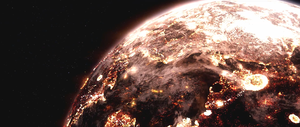
- "You are, all of you, vermin. Cowering in the dirt thinking, what, I wonder? That you might escape the coming fire? No. Your world will burn until its surface is but glass!"
- — The Prophet of Truth, to humans regarding Earth[1]
The term glassing, more formally known as plasma bombardment,[2] is used to refer to the act by which the Covenant's ships bombard a planet from orbit by using heavy plasma weaponry. Human colonies destroyed by this process would come to be referred to as the "glasslands".[3]
Doctrine
The process of glassing a planet begins when a fleet has achieved air and space superiority on an enemy-controlled world. The specifics of the glassing process vary depending on the strategic significance of the planet or the orders of the Fleet Master. A Minor Prophet or Minister is typically assigned to most Covenant fleets to oversee the destruction of a human world. In some or possibly all instances, before the fleet is permitted to destroy a planet, the Prophet performs a religious ritual—the Prophet declares by which religious ideal of the Covenant, marked by a glyph, will the world be destroyed. There is currently only one known instance of a human world, Kholo, having a glyph burned into its surface.[4]
Before bombardment commences, all Covenant ground operations cease and local forces are evacuated. The Covenant will then begin glassing the planet from orbit by moving their large warships close together, proceeding to blanket the world's population centers and the surrounding areas with a series of crisscrossing orbits to ensure that the planet is rendered uninhabitable.[5][note 1] The glassing of a planet by the Covenant is a very taxing process, and requires a massive amount of energy even for a Tier 2 civilization;[6][7] Nevertheless, the Covenant are able to accomplish this feat in an effective manner.
Glassing a planet can take a great deal of time, dependent upon both the tonnage and class of the vessels involved and how many ships are within the fleet. It could take as little as two days[8] or as much as two weeks[9] or longer to complete the process. While partial glassing can be accomplished in a matter of days, covering the entire surface area to the last centimeter would take a prohibitive amount of time. The Assembly believed that, were the Covenant to commit thousands of ships to the task, it would have taken them around thirty years to completely glass Earth alone; Earth's relatively small size, along with a myriad of other factors, would likely cause the thorough glassing of larger planets to take even longer.[7][note 2]
The Covenant have been known to utilize two methods of glassing.
Orbital bombardment
Typically, when fleet actions require no deployment of ground forces, the Covenant will glass the planet from orbit; this is accomplished by their larger warships gathering close together, aiming their plasma batteries, located along the lateral lines of their warships towards the surface and firing them.[10] Once discharged, the plasma rounds are guided towards the surface, contained in a magnetic bubble and controlled by the ships automation through miles of atmospheric interference until it strikes its intended target. Resembling gigantic fireballs,[11] these plasma lances are a hundred meters across,[11] and strike the surface with tremendous speed and force.
The impact of the plasma lance is similar to that of a nuclear detonation, though on a much different scale. When the plasma bolt impacts the surface, the magnetic field sustaining and guiding the plasma collapses, and, depending on how powerful the release of energy is, the initial zone of impact is obliterated instantly. The areas outside of the initial impact zone are affected by the heat wave generated by the blast; depending on the range, those closest outside of the blast zone are instantly killed by the intense heat. The topsoil in the impact zone and other surface geology become molten and are converted into a mineral called lechatelierite, which is similar to glass. The surrounding areas are blasted with intense heat and are burned.[12] The blast is accompanied by intense radiation, measured in tens of millions of roentgens.[13]
Subsequently, the atmosphere is saturated with millions of tons of ash, debris, and soot that are thrown up from the initial impact, blocking sunlight and dramatically lowering the amount of sunlight reaching the planets surface, subjecting it to an impact winter. As the ground zero area cools, the surface is covered by extensive areas of molten soil.[14]
Low-altitude bombardment
When ground engagements are in effect, the Covenant will resort to low range bombardment, bringing their ships closer to the surface to destroy the area in question. This is accomplished by either building up or focusing plasma though a magnetic envelope from the energy projector located on the underside of the ship, and then discharging the plasma as a narrow beam. A single CCS-class battlecruiser can glass approximately one acre of a planet's surface in fifteen seconds of sustained fire, with desert taking less time and deep ocean taking much longer to glass.[7] The Covenant use low-range bombardment in many battles where major ground engagements are occurring; smaller warships use this method specifically to deal with human armies and low-level structures during campaigns, while larger Covenant warships use this to level cities while engagements are occurring.
Low-range bombardment is not performed solely by energy projectors; smaller Covenant ships like corvettes are equipped with bombardment guns that fire smaller, less-powerful lances than those utilized by capital ships.[15] Capital ships and some smaller ships are equipped with excavation beams to excavate areas of interest for the Covenant, such as unearthing the Portal to Installation 00 during the Battle of Earth.
The Covenant sometimes glassed areas while their ground forces were still in the vicinity, ruthless as they were to eliminate humans.[13][16]
Aftermath
- "The brittle black shit on the outskirts of the huge swathes of destruction the Covenant leaves behind isn't actually glass, of course. It's what you get when you melt everything in the area into a chemical soup and let it cool and harden on its own—more like obsidian from a volcano than anything else."
- — Edward Buck, on the aftermath of a planet's glassing[17]

The destructive process of bombarding the surface of a planet with plasma leaves the surface unable to recover to its former state without re-terraforming. During the glassing of a planet the Covenant focus on destroying the ecosystem of a planet, and will spend a considerable amount of time vaporizing any bodies of water the planet may possess, or at least reduces the remaining water to small, ash-choked pools. The deeper the body of water is, the more time it will take to vaporize it.[7] Once the Covenant have finished the surface is dead, devoid of any life on the surface. From orbit the world is simply a series of grays, blacks, and reds,[18] everything on the surface is charred and the air is littered with ash and dust. The ash and material left behind from the glassing resembles obsidian. The glassing process does not render a world completely smooth; typically, internal scaffolding from structures can be found poking out of the "glass". The glass takes an extended period of time to cool down—as was the case with Draco III, where portions of the partially glassed planet was still hot nine years after its bombardment.[17] It is even possible for the atmosphere of a planet to boil away, or more correctly, suffer atmospheric escape from the process.[19] Glassed planets with an intact atmosphere often experience extreme weather phenomena, namely enormous storms.[20]
Because of the extensive destruction brought by the Covenant, the only way the world could recover is by re-terraforming efforts. The undertaking of such an effort would be massive and time consuming, ranging from a conservative 110 years to over 300 years given the manpower and technology at the time of such estimates.[21] However, these estimates were made in 2530, and human technology took drastic leaps forward in the wake of the Human-Covenant War over 20 years later, particularly due to advances brought forth by the discovery of Forerunner technology. It is apparent that such figures do not hold true in the post-war era, as Reach was at least partially reterraformed within thirty-seven years.[22]
Throughout the Human-Covenant War, areas of interest to the Covenant were left intact for reasons of study or retrieval; however, this was not common, as only a handful of planets were partially glassed and only when a Forerunner artifact was discovered.[23] After the Covenant glassed a planet, a shard of glass was removed and was placed in the Sanctum of the Hierarchs within High Charity.[24]
Limitations
While glassing is devastatingly powerful as an offensive tactic, doctrinal limitations prevented the Covenant from applying it indiscriminately in any combat situation. For example, "sacred" Forerunner artifacts, most notably the Halo installations, could not be targeted by glassing lest they are damaged by the bombardment. It was this reluctance to damage holy sites that allowed the UNSC Pillar of Autumn to land on Installation 04, and its complement to eventually score a victory against the Covenant forces. During the Raid on Reach, survivors from Battle of Installation 04 saw a certain area where the Covenant has yet to glass, due to their high interest in the Forerunner crystal. This allows them to rescue the remaining trapped UNSC survivors and salvage the UNSC Gettysburg from Reach.[25]
Glassing a planet even partially requires an enormous investment in time and resources, necessitating the use of hundreds of Covenant warships over the course of several days which could have been used for other purposes. Even with all that power, 'glassed' planets can still retain living biospheres complete with standing structures and vegetation, as is observed on Kholo.[26]
History
Since the formation of the Covenant in 852 BCE, the Covenant have used their ship-borne plasma weapons to threaten lesser species into a truce and their eventual induction into the Covenant. The Lekgolo were the first to be threatened with such destruction because of their transgressions against Forerunner technology before becoming the first outside species to join the Covenant in 784 BCE.[27][28] The Unggoy almost faced orbital bombardment for their rebellion in 2462 CE, or the 39th Age of Conflict by Covenant records.[29][30] Although the Kig-Yar were not threatened with orbital bombardment, they were quick to realize the Covenant had such a capacity to destroy them and thus chose to join the Covenant for the far greater wealth that the Covenant would provide.[31]
Human-Covenant War
- Main article: Human-Covenant War
After the Hierarchs' declaration to exterminate humanity, the Covenant put all of their destructive methods to use. The first planet to suffer this fate was Harvest, glassed by the Jiralhanae-operated battlecruiser Rapid Conversion.[32] Prior to the war, the territory of the Unified Earth Government comprised over eight-hundred planets; most of these worlds were glassed during the war.[33][34]
The term "glassing" was coined by the artificial intelligence group known as the Assembly in 2526. The group at the time estimated that it would take 30.3801 years for a Covenant fleet of comparable size to that of the UNSC's to glass Earth. The Assembly chose the term to magnify the horrible act in the hope that it would galvanize humanity into action.[7]
Throughout the rest of 2525 and 2526, the Covenant continued their campaigns in the Outer Colonies, glassing a number of worlds and human establishments including Biko, Green Hills, and Bliss. Admiral Cole and his fleet continued fighting for these colonies but they were lost causes, the Covenant with their determination, superior firepower and technology continued their ruthless campaign until the majority of the Outer Colonies were glassed by 2535. Each battle human forces face with the Covenant were brutal ground forces were often deployed first, but as UNSC forces were routed in space, the bombardment would commence resulting in either loss of life or retreat.[35]
The Covenant's bloody campaign continued as they moved into the Inner Colonies and began glassing major worlds. Throughout the 2540s, the UNSC continued their attempts at slowing the Covenant. Although some of their tactics succeeded, the Covenant continued to swarm human-controlled space, glassing every world they found. After the apparent death of Admiral Cole in 2543, the Covenant briefly halted their advance, then renewed their bloody tenacity and attacked human-controlled worlds with even more ferocity. After the Fall of Reach in the summer of 2552, which saw much of humanity's greatest stronghold glassed, the Covenant leadership believed that humanity would lose the will to fight.[36] However, this was a miscalculation, as humanity's disastrous defeat at Reach caused them to fight to the last breath, scoring a crushing victory at Installation 04, which would indirectly lead to the Great Schism, and with the crucial help of their new-found Sangheili allies, humanity would turn the tide in the Human-Covenant War.
The Battle of Earth culminated in the glassing of Mombasa in Africa as the Covenant, led by the Prophet of Truth uncovered the portal to Installation 00 buried beneath the city. This effort resulted in catastrophic and widespread devastation to the Kenyan landscape and forced the UNSC to regroup before their new allies arrived in force to thwart the Covenant's plans. The subsequent counterattack resulted in the glassing of the city of Voi by the Sangheili in an effort to contain a Flood infestation which had come to Earth only hours earlier.[37] Fleet Admiral Terrence Hood accused Shipmaster Rtas 'Vadum and the Fleet of Retribution of glassing half of the continent, but later views of Africa's surface showed only a relatively small area was scorched.[38][39] Given Hood's distaste for his former enemies, he probably exaggerated about the extent of the glassing. Concurrently, the Sangheili-controlled fleet established a perimeter around Installation 05 to prevent further spread of the Flood, completely glassing the installation's surface. Monitor 000 Tragic Solitude would later state that the surface of Installation 05 had been "scorched to char and ash" by the Sangheili ships.[40]
Post-war
Even after the culmination of the Human-Covenant War, several remnants of the former Covenant resumed the use of glassing against human colonies. The colony world of Cleyell was one such victim of glassing, with the entire planet being glassed in 2556 by a Covenant remnant with the exception of a single city.[41]
In September 2558, the Jiralhanae Chieftain Hekabe and his faction glassed the area outside of the city of Suraka using the ORS-class heavy cruiser Foebane in order to access the Sharquoi hive underneath. Though the Surakan Militia Volunteers eventually managed to destroy Foebane, Hekabe was able to successfully access the hive and unleash the Sharquoi.[42]
During the Second Ark Conflict in 2559, the Smart AI Isabel fired the energy projector of the CAS-class assault carrier Enduring Conviction at the surface of the Ark, effectively glassing a small area of the installation. Isabel's objective was to incite the Ark's defending Sentinels to destroy the Banished flagship by damaging the Ark. The tactic worked and the Sentinels responded in force, cutting the assault carrier in two and destroying it.[43]
List of known glassed worlds
2462: Balaho (partially)
2525: Harvest (partially), Second Base, Green Hills
2526: Biko, Bliss, Circinius IV, Etalan
2528: Madrigal
Before 2529: Asmara
2528/29: Hat Yai
Before 2530: Cote d'Azure, Verent
2530: Eridanus II
Before 2533: Sansar
2535: Jericho VII, Charybdis IX
Prior to 2537: Eirene
2537: Two out of three of the colony worlds in the Leonis Minoris star system
2539: Kholo
2542: Alluvion
2544: Miridem
2545: Draco III (partially), Actium
2546: New Llanelli
2547: Skopje
2550: Minab
2551: Meridian
2552: Troy, Harmony, Reach (partially), New Jerusalem, Coral, Installation 05 (partially), Tribute (partially), Earth (partially)
2553: Shaps III (partially)
2556: Cleyell
2558: Carrow (partially)
2559: Installation 00[43] (partially)
Unknown: Bounty, Camber, Endymion, Estuary, Greydowns, Kroedis II, Mesa, Reynes, Ruthersburg, Dwarka, Lostwithiel
Halo Wars gameplay

|
Browse more images in this article's gallery page. |
- "Burn, heretics!"
- — Regret, when using his Cleansing ability
In Halo Wars, the Prophet of Regret is able to call down a "Cleansing Beam" from an orbiting Covenant ship. Rather than a leader power, this is treated as the unit's secondary ability, using the left control stick to guide the beam at the cost of resources every second. It lacks the power of typical glassing maneuvers to balance gameplay, much like Captain Cutter's ability to fire a MAC blast at enemy targets. The upgrades Regret’s Sentence, Regret’s Doom, and Regret's Condemnation increase its blast radius, though they require a higher tech level to purchase.
Gallery
The Fleet of Retribution glassing Voi to contain the Flood infection on Earth.
Three Covenant destroyers glassing Harvest in Halo Wars: Genesis.
Harvest, partially glassed by the Covenant in Halo Wars.
- Glassinglaz0r.jpg
The Cleansing Beam in Halo Wars.
New Mombasa being glassed in Halo 3: ODST.
The Prophet of Truth’s fleet uncovers the Portal at Voi.
- Kholo.png
Covenant ships glassing Kholo in The Return.
Reach's surface being bombarded in Halo: Reach.
A CCS-class battlecruiser glassing New Alexandria.
The Military Wilderness Training Preserve on Reach is glassed by CCS-class battlecruisers.
A glassed planet on the cover of Halo: Glasslands.
Multiple CCS-class battlecruisers glassing Circinius IV in Halo 4: Forward Unto Dawn.
One of many worlds glassed by the Fleet of Particular Justice in Halo 2: Anniversary's terminals.
The members of Blue Team meeting up in Reach's glasslands in Halo: The Fall of Reach - The Animated Series.
The glassed surface of Meridian in Halo 5: Guardians.
Enduring Conviction glassing Installation 00 in Halo Wars 2.
List of appearances
Notes
- ^ According to earlier media, such as the original printing of Halo: First Strike, the Covenant glassed every square centimeter of a planet. However, later media show a more practical approach to glassing in which only part, perhaps most, of a planet is glassed in order to render it uninhabitable; the 2011 re-release of Halo: First Strike was modified to accommodate this.
- ^ While the Assembly asserts in Data Pad 10 that glassing a whole planet is a feat too impractical for the Covenant to feasibly achieve, the rest of canon contradicts this. Numerous instances are listed in the novels where glassing and glassed planets are observed, as well as in Halo: Reach where the data pads are from, since Reach's burnt surface is the opening shot of the game. Possible reasons for this discrepancy may be that the Assembly had only observed low-altitude bombardment, which is much slower and precise, or that they had misjudged the size of the full Covenant fleet, since they had based their figures on a fleet the size of the UNSC's. While the Assembly never explicitly retracts its statement, it does however state in Data Pad 14 that terraforming on the first eight colonies lost could take up to 3 centuries, an unusually long figure if those planets' full surfaces were never scorched. Based on the sum of the canon, it is thus assumed here that glassing is indeed a true method of attack by the Covenant.
Sources
- ^ Halo 3, campaign level Crow's Nest
- ^ Halo: First Strike, page 105 (2003 edition); page 136 (2010 edition)
- ^ Halo: Glasslands, page 295
- ^ Halo: Evolutions, "The Return", pages 494-496
- ^ Halo: First Strike, page 130 (2010 edition)
- ^ Halo: Evolutions, "The Return", page 495
- ^ a b c d e Halo: Reach, Data pad 10
- ^ Halo Legends, Halo: The Story So Far
- ^ Halo: The Fall of Reach (2010), Adjunct - page 389
- ^ Halo: The Fall of Reach, page 8 (2001 edition); page 22 (2010 edition)
- ^ a b Halo: First Strike page 32, 46
- ^ Halo: Evolutions, "The Return", page 505
- ^ a b Halo: Reach, campaign level New Alexandria
- ^ Halo: Glasslands, page 153
- ^ Halo: Reach Legendary Edition Guide page 440
- ^ Halo: Reach, campaign level The Pillar of Autumn
- ^ a b Halo: New Blood, pages 103-104 (Google Play edition)
- ^ Halo: First Strike Bonus Content page 417
- ^ Halo: The Fall of Reach, page 8 (2001 edition); page 23 (2010 edition)
- ^ Hunt the Truth, Episode 11: DOWN TO THE BONE
- ^ Halo: Reach, Data pad 14
- ^ Halo: Reach, campaign level Lone Wolf
- ^ Halo: First Strike page 122 (2003 edition); page 150 (2010 edition)
- ^ Halo: First Strike page 338 (2003 edition); page 405 (2010 edition)
- ^ Halo: First Strike
- ^ Halo: Evolutions, "The Return", Motion Comic Adaptation
- ^ Halo: Contact Harvest page 270
- ^ Halo Encyclopedia page 114
- ^ Halo: Contact Harvest, page 151
- ^ Halo Encyclopedia page 142
- ^ Halo Encyclopedia page 121
- ^ Halo: Contact Harvest page 285
- ^ Halo Encyclopedia, "Chapter 1", page 33
- ^ Xbox.com: The Halo Timeline
- ^ Halo: The Fall of Reach page 173; page 199 (2010 edition)
- ^ Halo: Evolutions, "The Return", page 499
- ^ Halo 3, campaign level Floodgate
- ^ Halo 3, campaign level, Halo
- ^ File:PortalOrbit.png
- ^ Halo: Hunters in the Dark, page 272
- ^ Halo: Escalation, Issue #17
- ^ Halo: Envoy
- ^ a b Halo Wars 2, campaign level Under the Dark
